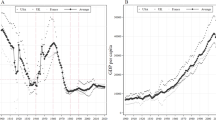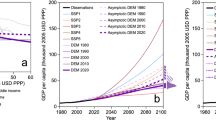Abstract
During the twentieth century, the global population has gone through unprecedented increases in economic and social development that coincided with substantial declines in human fertility and population growth rates1,2. The negative association of fertility with economic and social development has therefore become one of the most solidly established and generally accepted empirical regularities in the social sciences1,2,3. As a result of this close connection between development and fertility decline, more than half of the global population now lives in regions with below-replacement fertility (less than 2.1 children per woman)4. In many highly developed countries, the trend towards low fertility has also been deemed irreversible5,6,7,8,9. Rapid population ageing, and in some cases the prospect of significant population decline, have therefore become a central socioeconomic concern and policy challenge10. Here we show, using new cross-sectional and longitudinal analyses of the total fertility rate and the human development index (HDI), a fundamental change in the well-established negative relationship between fertility and development as the global population entered the twenty-first century. Although development continues to promote fertility decline at low and medium HDI levels, our analyses show that at advanced HDI levels, further development can reverse the declining trend in fertility. The previously negative development–fertility relationship has become J-shaped, with the HDI being positively associated with fertility among highly developed countries. This reversal of fertility decline as a result of continued economic and social development has the potential to slow the rates of population ageing, thereby ameliorating the social and economic problems that have been associated with the emergence and persistence of very low fertility.
This is a preview of subscription content, access via your institution
Access options
Subscribe to this journal
Receive 51 print issues and online access
$199.00 per year
only $3.90 per issue
Buy this article
- Purchase on Springer Link
- Instant access to full article PDF
Prices may be subject to local taxes which are calculated during checkout



Similar content being viewed by others
References
Bryant, J. Theories of fertility decline and the evidence from development indicators. Popul. Dev. Rev. 33, 101–127 (2007)
Lee, R. D. The demographic transition: three centuries of fundamental change. J. Econ. Perspect. 17, 167–190 (2003)
Bongaarts, J. & Watkins, S. C. Social interactions and contemporary fertility transitions. Popul. Dev. Rev. 22, 639–682 (1996)
Wilson, C. Fertility below replacement level. Science 304, 207–209 (2004)
Lutz, W., Sanderson, W. & Scherbov, S. The coming acceleration of global population aging. Nature 451, 716–719 (2008)
Lutz, W., O’Neill, B. C. & Scherbov, S. Europe’s population at a turning point. Science 299, 1991–1992 (2003)
Bongaarts, J. Demographic consequences of declining fertility. Science 282, 419–420 (1998)
Kohler, H.-P., Billari, F. C. & Ortega, J. A. The emergence of lowest-low fertility in Europe during the 1990s. Popul. Dev. Rev. 28, 641–681 (2002)
Butler, D. The fertility riddle. Nature 432, 38–39 (2004)
Balter, M. The baby deficit. Science 312, 1894–1897 (2006)
United Nations Development Programme. Statistics of the Human Development Report (UNDP Human Development Report Office) 〈http://hdr.undp.org/en/statistics/〉 (29 September 2008)
United Nations. Replacement Migration: Is It a Solution to Declining and Ageing Populations? (United Nations, 2000)
Wooldridge, J. M. Econometric Analysis of Cross Section and Panel Data. Ch. 10 (MIT Press, 2002)
Sobotka, T. Is lowest-low fertility in Europe explained by the postponement of childbearing? Popul. Dev. Rev. 30, 195–220 (2004)
Bongaarts, J. & Feeney, G. On the quantum and tempo of fertility. Popul. Dev. Rev. 24, 271–291 (1998)
Brewster, K. L. & Rindfuss, R. R. Fertility and women’s employment in industrialized nations. Annu. Rev. Sociol. 26, 271–296 (2000)
McDonald, P. Gender equity in theories of fertility transition. Popul. Dev. Rev. 26, 427–440 (2000)
Neyer, G. & Andersson, G. Consequences of family policies on childbearing behavior: effects or artifacts? Popul. Dev. Rev. 34, 699–724 (2008)
Billari, F. C. & Kohler, H.-P. Patterns of low and lowest-low fertility in Europe. Popul. Stud. 58, 161–176 (2004)
Suzuki, T. Lowest-low fertility in Korea and Japan. J. Popul. Probl. 59, 1–16 (2003)
Lutz, W., Sanderson, W. & Scherbov, S. The end of world population growth. Nature 412, 543–545 (2001)
Acknowledgements
M.M. acknowledges support from the University of Pennsylvania, the Finnish Cultural Foundation, and the Ella and Georg Ehrnrooth foundation. H.-P.K. acknowledges the support provided by the Center for Advanced Studies at the Norwegian Academy of Science and the University of Pennsylvania. F.C.B. acknowledges support from Università Bocconi, the Italian Ministry for University and Research and the Distinguished International Scholars Program at the University of Pennsylvania. We are grateful to T. Sobotka for the provision of tempo-adjusted fertility data used in our analyses.
Author Contributions All authors contributed equally to this paper.
Author information
Authors and Affiliations
Corresponding author
Supplementary information
Supplementary Information
This file contains Supplementary Data and Methods including Supplementary Tables S1-S3 and Supplementary Figures S1-S2 with Legends and Supplementary References. (PDF 232 kb)
Supplementary Data
This dataset file contains the HDI and TFR data used in analyses for this article. (ZIP 37 kb)
Supplementary Script 1
This file contains the R Scripts to replace replicate figures in this article. (ZIP 3 kb)
Supplementary Script 2
This file contains the R script with functions necessary for Script 1. (TXT 3 kb)
Supplementary Script 3
This file contains the SAS Script for replicating regression results. (ZIP 3 kb)
Rights and permissions
About this article
Cite this article
Myrskylä, M., Kohler, HP. & Billari, F. Advances in development reverse fertility declines. Nature 460, 741–743 (2009). https://doi.org/10.1038/nature08230
Received:
Accepted:
Issue Date:
DOI: https://doi.org/10.1038/nature08230
This article is cited by
-
A reassessment of trends and rural–urban/regional differences in the total fertility rate in China, 2000–2020: analyses of the 2020 national census data
Scientific Reports (2024)
-
How do urban public health services affect rural migrant women's fertility intentions? A study based on the Mobile Population Dynamics Monitoring Survey in China
BMC Health Services Research (2023)
-
Multidecadal dynamics project slow 21st-century economic growth and income convergence
Communications Earth & Environment (2023)
-
Differential fertility, school enrollment, and development
Journal of Population Economics (2023)
-
A Spatial Perspective on the Unexpected Nordic Fertility Decline: The Relevance of Economic and Social Contexts
Applied Spatial Analysis and Policy (2023)
Comments
By submitting a comment you agree to abide by our Terms and Community Guidelines. If you find something abusive or that does not comply with our terms or guidelines please flag it as inappropriate.



